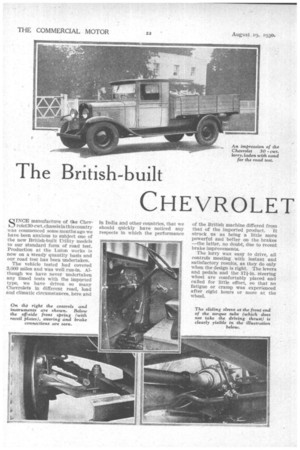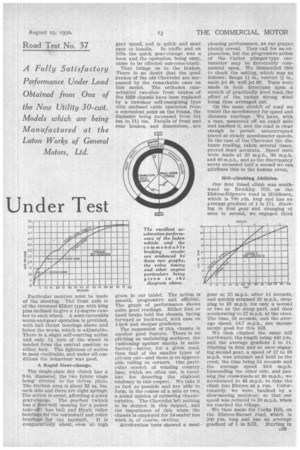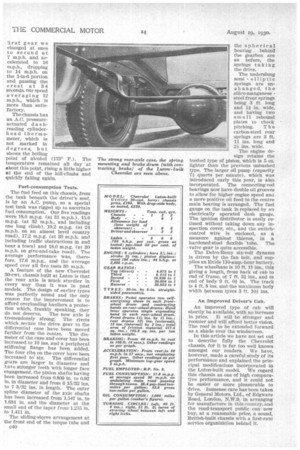The British-built
Page 60

Page 61

Page 62

If you've noticed an error in this article please click here to report it so we can fix it.
CHEVROLET
Under Test
CI INCE manufacture of the Chevk) rolet 30-cwt. chassis in this country was commenced some months ago we have been anxious to subject one of the new British-built Utility models to our standard form of road test. Production at the Luton works is now on a steady quantity basis and our road test has been undertaken.
The vehicle tested had covered 3,000 miles and was well run-in. Although we have never undertaken any timed tests with the imparted type, we have driven so many Chevrolets in different road, load and climatic circumstances, here and In India and other countries, that we should quickly have noticed any respects in which the performance of the British machine differed from that of the imported product. It struck us as being a little more powerful and better on the brakes —the latter, no doubt, due to recent brake improvements.
The lorry was easy to drive, all controls meeting with instant and satisfactory results, as they do only when the design is right. The levers and pedals and the 17i-in. steering wheel are comfortably placed and called for little effort, so that no fatigue or cramp Was experienced after eight hours or more at the wheel. Particular mention must be made of the steering. The front axle is of the reversed Elliott type with king pins inclined to give a 1i-degree camber to each wheel. A semi-reversible -worm-and-gear operation is provided, with ball thrust bearings above and below the worm, which is adjustable. There is a slight self-centring action and only II turn • of the .wheel is needed from the central position to either, leek. The lightness of action is most creditable, and under all conditions the behaviour was good.
A Rapid Gear-change.
The single-plate dry clutch has a• 9-in. diameter, the two fabric rings being-riveted to Abe driven plate. The friction area is about 33 sq. ins. each side and there are eight springs. The action is sweet, affording a quick gear-change. The. gearbox -( which has nfour-bolt opening for a power take-off) has .ball and Hyatt roller bearings fer the inainshaft and roller
bearings for . the layShaft. It is • comparatively silent; even 'at high gear speed, and is quick and most easy to handle. In traffic and on hills the quick gear-change was a boon and the operation, being easy, came to be effected sub-consciousIy.
That brings us to the brakes. There is no doubt that the good brakes of the old Chevrolet are surpassed by the remarkable ones on this model. The orthodox camactuated two-shoe front brakes of the 1929 chassis have been replaced by a two-shoe self-energizing type with enclosed cable operation from a convenient point on the frame, the diameter being increased from VA ins. to 111 ins. Details 4-4 front and rear brakes, and dimensions,.. are
given in our tablet. The action is smooth, progressive and efficient. The graph of performance shows quite good readings. Either foot or hand brake held the chassis, facing forward or backward, with ease on 1-in-6 and steeper gradients.
The suspension of this chassis is another good feature. There is no pitching on undulating surfaces, the cushioning • against shocks is satisfactory-better, for a given roaJ, than that of the smaller types of private car—and there is no appreciable rolling on corners. One particular stretch of winding country lane, which we often use, is excellent for detecting the slightest tendency in this respect. We take it as fast as possible and are able to form, in the course of a mile or two, a sound opinion of cornering characteristics.: The-Chevrolet left nothing to be desired in this respect, and .the importance of this whenthe _ chassis is employed for -14-seater bus
• work .is, of course, obvieus.
Acceleration tests showed a most pleasing performance, as our graphs plainly reveal. They-call for no explanation, but the progressive action of the Carter plunger-type carburetter may be favourably commented upon. We dismantled this te check the setting, which was as follows: flange fl in., venturi ft in., main jet 48, well jet 60. Tests were made in both directions upon a stretch of practically level road, the effect of the rather 'strong wind being thus averaged out.
On the same stretch of road we tested the speedometer for speed and distance readings. We have, with a tape, measured off an exact mile and marked it, and the road is clear enough to permit uninterrupted travel at steady speedometer speeds. In the ease of the Chevrolet the distance reading, taken several times, proved dead accurate. Speed tests were made at 20 m.p.h., 30 m.p.h. and 40 m.p.h., and as the discrepancy never exceeded half a second we can attribute this to the human error.
Hill-climbing Abilities.
Our first timed climb was southward up Brockley Hill, on the Elstree-Edgware road in Middlesex, which is 700 yds. long and has an average gradient of 1 in 17i. Starting in first gear and changing at once to second, we engaged third gear at 15 m.p.h. after 11 seconds, and quickly attained 26 m.p.h., dropping to 23 m.p.h. for only a second or two at the steep part, and then accelerating-to 27 m.p.h. at the crest. The time, 58 seconds, and the average speed, 24.7 m.p.h., are uncomixenly good for this hill.
We then climbed the same hill northward, the length being 440 yds. and the average gradient 1 in 11. Starting in first and at once engaging second gear, a speed of 17 to 18 m.p.h. was attained and held to the crest, the time being 54 seconds and the average speed 16.6 m.p.h. Descending the other side, and passing the cross-roads at 30 m.p.h., we accelerated to 43 m.p.h. to take the climb into Elstree at a run: Unfortunately, we were . baulked by a slow-moving motorcar, so that our speed was reduced to20 m.p.h. when we reached the village.
We then made for Cocks Hill, on the Elstree-Barnet road, which is 200 yds. long and has an average gradient of 1 in 8,57. Starting in first gear we changed at once to second at 7 m.p.h. and accelerated to 16 dropping to 14 m.p.h. on the 1-in-6 portion and passing the crest at 34 seconds, our speed averaging 12 m.p.h., which is more than satisfactory.
The chassis has an A.C. pressureactuated d a a reading cylinderhead cylinderhead thermo meter, which is not marked in degrees, but shows the boiling point of alcohol (173° F.). The temperature remained all day at about this point, rising a little higher at the end of the hill-climbs and quickly falling again.
Fuel-consumption Tests.
The fuel feed on this chassis, from the tank beneath the driver's seat, is by an A.C. pump, so a special test tank was rigged up to ascertain fuel consumption. Our five readings were 18.0 m.p.g. (at 31 m.p.h.), 15.6 m.p.g. (at 32 m.p.h., and including one long climb), 19.2 m.p.g. (at 24 m.p.h. on an almost level country road), 17.2 ni.p,g. (at 33 m.p.h. and including traffic obstructions in and near a town) and 18.0 m.p.g. (at 30 m.p.h. on give-and-take road). The average performance was, therefore, 17.6 m.p.g., and the average speed over all five tests 30 m.p.h. A feature of the new Chevrolet 30-cwt. chassis built at Luton is that the rear axle is much sturdier in every way than It was in past models. The design of earlier types was perfectly sound and the only reason for the improvement is to afford overloading hauliers a protection which, . frankly speaking, they do not deserve. The new axle is tremendously strong. The rivets which. secure the drive gear to the differential case have been moved farther from the centre. The diameter of the. case and cover has been increased. to 10 ins, and a peripheral stiffening flange has been added. The four ribs on the cover have been increased to' six. The differential gears are larger in diameter and have stronger teeth with longer face engagement, the pinion shafts having been increased from 0.809 in. to 0.92 in. in diameter and from 6 15/32 ins. to 7 3/32 ins. in length. The outer spline diameter of the axle shafts has been increased from 1.547 in. to 1.634 in. and the diameter at the small end of the taper from 1.255 in.
to 1.411 in. •
The sliding-sleeve arrangement at the front end of the torque tube and
040 the spherical bearing behind' the gearbox are as before, the springs taking the drive.
The underslung semi elliptic springs are unnhanged, the silico-manganese steel front springs being 3 ft. long and 11 in, wide, and having two small rebound plates to check pitching. The carbon-steel rear springs are 3 ft. -11 ins, long and 21 ins. wide.
The engine design retains the bushed type of piston, which is 5 oz. lighter than the previous unbushed type. The larger oil pump (capacity 7i quarts per minute), which was introduced early this year, is also incorporated. The connecting-rod bearings now have double oil grooves to allow for higher engine speed anti a more positive oil feed to the centre main bearing is arranged. The fuel gauge on the tank is replaced by an electrically operated dash gauge. The ignition distributor is easily retimed without taking down any inspection cover, etc., and the switchcontrol wire is enclosed, as a measure against thieves, in a hardened-steel flexible 'tube. The valve gear is quite accessible.
The Delco-Remy six-volt dynamo is driven by the fan belt, and supplies an Exide 110-amp.-hour battery.
The wheelbase is 10 ft. 11 ins., this giving a length, from back of cab to Cud of frame, of 7 ft. 31 ins., and to end of body 9 ft. Of in. The track is 4 ft. 8 ins, and the maximum body width between tyres 3 ft. 101 ins.
An Improved Driver's Cab.
An improved type of cab will shortly, be available, with no increase in price. It will be stronger and roomier and will afford better vision. The roof is to be extended forward as a shade over the windscreen.
In this article we have not set out to describe fully the Chevrolet chassis, fat it is far too well known amongst our readers. We have, however, made a careful study of its performance and explained the principal modifications incorporated in the Luton-built model. We regard this chassis as one of high comparative performance, and it could not be easier or more pleasurable to 'drive. Immense care has been taken by General Motors, Ltd., of Edgware Road, London, N.W.9, in arranging for manufacture in this country, and the road-transport public can now buy, at a reasonable price, a sound, British-built chassis with a first-rate service organization behind it.












































































































